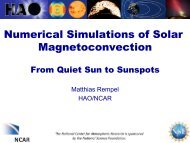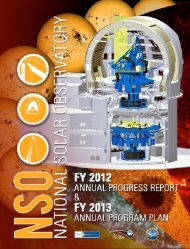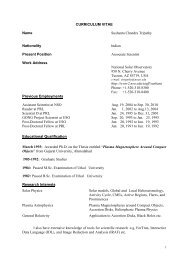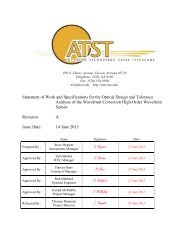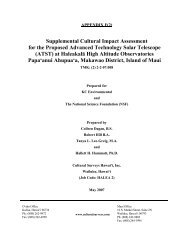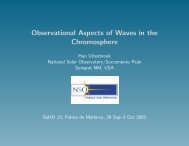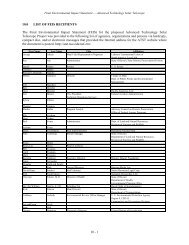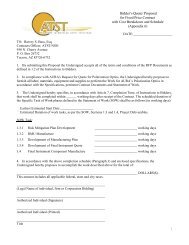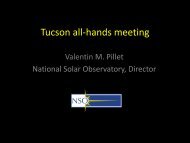Helioseismology in Space Weather - National Solar Observatory
Helioseismology in Space Weather - National Solar Observatory
Helioseismology in Space Weather - National Solar Observatory
- No tags were found...
Create successful ePaper yourself
Turn your PDF publications into a flip-book with our unique Google optimized e-Paper software.
<strong>Helioseismology</strong> <strong>in</strong> <strong>Space</strong> <strong>Weather</strong>Irene González Hernández<strong>National</strong> <strong>Solar</strong> <strong>Observatory</strong>, Tucson, AZ
<strong>Helioseismology</strong> of Active RegionsTowards Seismology of Active Regions“The Spatial Distribution of p-Mode Absortion <strong>in</strong> Active Regions”Braun, D. C., LaBonte B. J. and Duvall, T.L. Jr. 1990, ApJ, 354, 372“Scatter<strong>in</strong>g of p-Modes by a Sunspot”Seismic Imag<strong>in</strong>g of Sunspots <strong>in</strong> theFar Side of the SunL<strong>in</strong>dsey, C. and Braun D., 1990, <strong>Solar</strong>Physics, 126, 101Braun, D. C., Duvall, T.L. Jr., LaBonte, B.J., Jefferies, S.M., Harvey, J.W.and Pomerantz, M.A. 1992, ApJ, 391L, 113Time-distance helioseismologyDuvall et al., 1993, Nature, 362,430
<strong>Helioseismology</strong> of Active RegionTime distance: First seimic image of an active regionus<strong>in</strong>g a local helioseismology technique (time-distance)Ambient Acoustic Imag<strong>in</strong>g: Constructed outgo<strong>in</strong>g <strong>in</strong>tensitymap and phase-shift map at the surface and 10 Mm at 5mHzØ Chang, H.-K.,Chou, D.-Y.;Labonte, B. and the TONTeam, 1997, Nature, 389,825.Ø Chou, D.-Y., 2000, <strong>Solar</strong>Physics, 192, 241Helioseismic holography: First seimic image of activeregions <strong>in</strong> the far side of the SunDuvall, T., D’Silva, S., Jefferies, S.M., Harvey,J.W. and Schou, 1996, Nature, 379, 235L<strong>in</strong>dsey, C. and Braun, D. C. 2000, Science, 287, 1799
<strong>Helioseismology</strong> of Active Regions16 oq Hill, F; 1988, ApJ,333,996q Patrón, J.; Hill, F.;Rhodes,E.J.,Jr.;Korzennik,S. G. andCacciani,A., 1995, ApJ, 455,746
<strong>Helioseismology</strong> of Active RegionsCourtesy of R. Komm
Helioseismic Imag<strong>in</strong>g of the FarsidePhase of theCorrelation∫C( r,z,τ ) dtH ( r,z,t)H ( r,z,t + τ )=+−0 180 360Carr<strong>in</strong>gton Longitude (degrees)
Current Far-side MapsMagnetic field strength calibration(González Hernández, I.; Hill, F.;L<strong>in</strong>dsey, C, 2007, ApJ)<strong>Solar</strong> cycle variation of the “quiet Sun” <strong>in</strong>the far-side maps (González Hernández,Scherrer and Hill 2009 ApJ Letters)Confidence level (González Hernández, Hill,Scherrer, L<strong>in</strong>dsey, and Braun 2010 <strong>Space</strong><strong>Weather</strong> Journal)C. Long. Latitude Phase-shift Prob. Effective-Area Date-of-return Front-sidenumber203.039993 -19.876875 -0.159418 87 84.239998 20100911 NOAA 11100
<strong>Solar</strong> Spectral Irradiance Forecast<strong>in</strong>gLyman-alpha scattered mapof the farside from SWANFontenla, J. M., et al., 2009, Advances <strong>in</strong><strong>Space</strong> Research, 44, 457, “<strong>Solar</strong> IrradianceForecast and Far-Side Imag<strong>in</strong>g”
Input Data<strong>Solar</strong>MagnetogramDataIncorporat<strong>in</strong>g Far-Side Observations<strong>in</strong>to ADAPTIntelligent FrontEnd !Import & SelectDataforData AssimilatorADAPTInitial ConditionsData AssimilatorForecast Step:use the WHmodel tocalculateforecastModel<strong>in</strong>g / Forecast<strong>in</strong>gApplicationsImproved<strong>Solar</strong> SynopticMapsCoronal &<strong>Solar</strong> W<strong>in</strong>dModelsWSA+ENLILMagneticFieldVarianceAnalysis Step:comb<strong>in</strong>eobservations withforecastFar-side mapPolarity+ErrorEstimationAssimilation ResultsGlobalMagnetic FieldWSA-ENLIL<strong>Solar</strong> W<strong>in</strong>dDiagram of the general data flow and process<strong>in</strong>g of ADAPT: the Intelligent Front End imports and selects the bestavailable magnetogram data, along with estimated uncerta<strong>in</strong>ties, to be assimilated by the ensemble least-squares (EnLS)method with the latest WH flux transport map of the global solar magnetic field. These maps are then used as <strong>in</strong>put forcoronal and solar w<strong>in</strong>d models, e.g., WSA-ENLIL (Odstrcil et al. , 2005) .
ADAPT: Photospheric Field(Before & After Far-Side Active Region Insertion)Large, GONGdetected far-sideactive region<strong>in</strong>serted <strong>in</strong>to theADAPT map on July1, 2010June 30, 2010Without Active RegionInsertedJuly 1, 2010With Active RegionInsertedArge, N. et al (<strong>Solar</strong> W<strong>in</strong>d 13 presentation, June 2012)
• WSA Coronalholes - Whitecontours• STEREO A&BEUVI - GreenareasWSA Model Coronal Holes vs.STEREO EUVI ObservationsJuly 1, 2010June 30, 2010STEREO BWithout Active Region Inserted July 1, 2010Note coronalhole changesSTEREO AWith Active Region InsertedArge, C. N. et al (<strong>Solar</strong> W<strong>in</strong>d 13 presentation, June 2012)
WSA <strong>Solar</strong> W<strong>in</strong>d Speed vs Observationsat STEREO BWithout Far-Side Active Region Inserted4 Day Advanced Predictions and STEREO B ObservationsWith Far-Side Active Region Inserted4 Day Advanced Predictions and STEREO B ObservationsICMEFar-side Active regionInserted on July 1 at 20 UTArge, C. N. et al (<strong>Solar</strong> W<strong>in</strong>d 13 presentation, June 2012)
F 10.7 Forecast<strong>in</strong>g Us<strong>in</strong>g ADAPT(with/without Far-side)Far-side data merged withADAPT map on July 1 at 20 UT.Henney, C. et al (26 th NSO Workshop presentation, May 2012)
A Full Sun Magnetic Index from <strong>Helioseismology</strong>InferencesComparison of the Near Side SeismicMagnetic Index (NSSMI) with the MountWilson Sunspot Index (MWSI) and the F10.7observations from the beg<strong>in</strong>n<strong>in</strong>g of 2002 tothe end of 2005. The simultaneous Far SideSeimic Magnetic Index (FSSMI) and the fullSun Seismic Magnetic Index are presented <strong>in</strong>the same figure. The characteristic 27-daymodulation can be seen <strong>in</strong> both the near-sideand the far-side <strong>in</strong>dices. Two cases have beenhighlighted with l<strong>in</strong>es separated by 14 days. (I.Gonzalez Hernandez, M. Diaz Alfaro, K.Ja<strong>in</strong>, W.K. Tobiska, D.C. Braun, F. Hill, F.Perez Hernandez, 2012, SoPh, submitted)
Validation of far-side seismic mapsSTEREOMay 3 2013HMIGONG
Future (Easy) ImprovementsGONGHMISTEREO
Far-side seismic maps: Next GenerationScientific Products for modelersAR Detection/Localization for<strong>Space</strong> <strong>Weather</strong> forecastersMagnetic FieldStrengthUncerta<strong>in</strong>tiesProbabilityEffective AreaFits Files
Flares and subsurface dynamicsUs<strong>in</strong>g quantities averaged over the disk passage of active regions, we f<strong>in</strong>d that, while there is a considerable spread of the flux andvorticity values, they are more or less l<strong>in</strong>early related. We dist<strong>in</strong>guish the level of flare activity by X-ray flare class and f<strong>in</strong>d that largeflux or large vorticity values are sufficient for an active region to produce low-<strong>in</strong>tensity C-class flares. Active regions that producehigh-<strong>in</strong>tensity X-class flares are characterized by large values of both flux and vorticity. Active regions that produce M-class flaresof <strong>in</strong>termediate <strong>in</strong>tensity are characterized by large vorticity values. The <strong>in</strong>clusion of solar subsurface vorticity thus helps todist<strong>in</strong>guish between flar<strong>in</strong>g and nonflar<strong>in</strong>g active regions.Komm, R. and Hill, F. 2009, JGRA, 114
Flares and subsurface dynamicsTotal flare<strong>in</strong>tensity of activeregions dur<strong>in</strong>gtheir diskpassage as afunction ofunsignedsubsurfacevorticity at 12Mm.Two-dimensionalhistogram of thenumber of activeregion as afunction ofunsignedmagnetic flux andunsignedsubsurfacevorticity at 12 Mm.Komm, R. and Hill, F. 2009, JGRA, 114
Flares and subsurface dynamicsRe<strong>in</strong>ard, A.A. et al., 2010, ApJ, 710, 121
Emerg<strong>in</strong>g Active RegionsOrig<strong>in</strong>al Paper: Ilonidis, S.,Zhao, J. and Kosovichev, A. , 2011,Science 333,993,“Detection of Emerg<strong>in</strong>g Sunspot Regions <strong>in</strong> the <strong>Solar</strong> Interior”-11 hoursIlonidis, S.,Zhao, J. and Kosovichev, A. 2012, Proc.Of the 61 st Fujihara Sem<strong>in</strong>ar: Progress <strong>in</strong> solar/stellar physics with helio-and asteroseismology-3 hoursAnalysis of 9 quiet-Sun regions to estimate noiselevel: quiet Sun showed no significant travel-timeperturbations, standard deviation was 3.3,yield<strong>in</strong>g S/N for AR’s 10488 and 8164 4.9 and4.2 respectivelyThese travel-time anomaliescorrespond to very large speeds !!
Emerg<strong>in</strong>g Active RegionsHelioseismic holography is applied tosamples of the two populations (preemergenceand without emergence), eachsample hav<strong>in</strong>g over 100 members, whichwere selected to m<strong>in</strong>imize systematic bias,as described <strong>in</strong> Leka et al.Birch, A. et al, 2012, ApJ, 762We f<strong>in</strong>d that there are statistically significantsignatures (i.e., difference <strong>in</strong> the means of morethan a few standard errors) <strong>in</strong> the averagesubsurface flows and the apparent wave speed thatprecede the formation of an active region. Themeasurements here rule out spatially extendedflows of more than about 15 m/s <strong>in</strong> the top 20Mm below the photosphere over the course of theday preced<strong>in</strong>g the start of visible emergence.These measurements place strong constra<strong>in</strong>ts onmodels of active region formation.
Emerg<strong>in</strong>g Active RegionsBirch, A. et al, 2012, ApJ, 762
Emerg<strong>in</strong>g Active Regionsq Braun, D. C., Science, 336, 296. “Comment on Detection of Emerg<strong>in</strong>g SunspotRegions <strong>in</strong> <strong>Solar</strong> Interiorq Ilonidis, S., Zhao J. and Kosovichech, A. “Response to Comment on Detection ofEmerg<strong>in</strong>g Sunspot Regions <strong>in</strong> <strong>Solar</strong> Interiorü On the orig<strong>in</strong>g of the large time difference: “The observed phase-shifts can be causednot only by sound-speed and magnetic-field perturbations or plasma flows, but also by morecomplex effects such as absorption and scatter<strong>in</strong>g. There has been also evidence, both fromobservations and simulations, that submerged magnetic regions can modify the acoustic powerabove them”q Braun, D. C., 2012, <strong>Solar</strong> Physics, tmp 306B “Helioseismic Holography of anArtificial Submerged Sound Speed Perturbation and Implications for the Detection ofPre-emergence Signatures of Active Regions
Emerg<strong>in</strong>g Active RegionsDeep focus<strong>in</strong>g travel time maps ofthe Active Region 10488 The focusdepth for these measurements covers40-70 Mm. The color scale <strong>in</strong> thetravel time maps covers theperturbation range 0 (blue) to -15(red) seconds.The maximum time shiftmagnitude is observed at around1:30 UT, October 26.The magnetic fields before and afterthe emergence time and thecont<strong>in</strong>uum image for a later time arepresented <strong>in</strong> the last three panels ofthe bottom row.Courtesy of Shukur Kholikov (<strong>Solar</strong> Physics accepted)
Ø Far-side seismic mapsSummary• Already used as a space weather tool• Improve stability of signal and detection capability.• Encourag<strong>in</strong>g results when us<strong>in</strong>g as <strong>in</strong>put to solar models for spaceweather <strong>in</strong> case studies.Ø Flare activity and subsurface flows• Statistical analyses show potential• Need to be <strong>in</strong>vestigated for <strong>in</strong>dividual eventsØ Predict<strong>in</strong>g the emergence of active regions• Encourag<strong>in</strong>g and <strong>in</strong>terest<strong>in</strong>g <strong>in</strong>itial results• Work <strong>in</strong> progress…..



